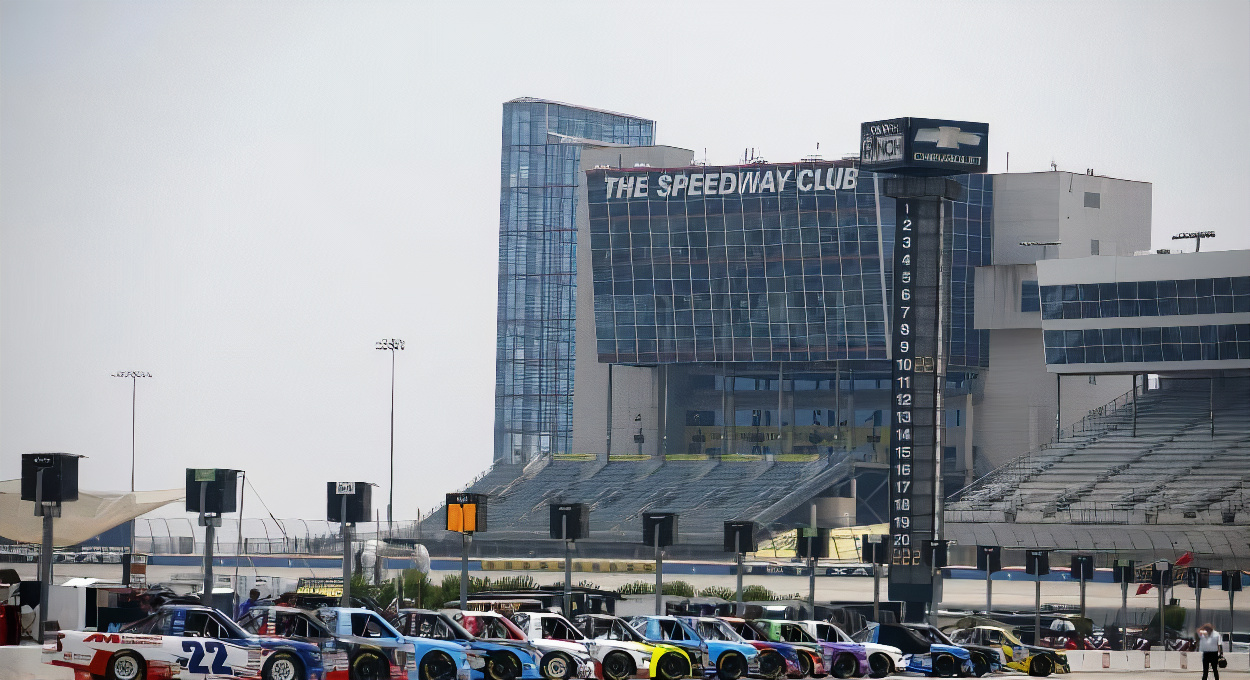When taking questions about the removal of scoring pylons across the NASCAR schedule, Denny Hamlin simply pointed to the television screen behind him and said the concept is so important that broadcasts essentially use them too.
“Listen, they are so important, they put them on TV for you,” he said. “It’s important.”
He then pointed to the at-track closed circuit monitor, that only shows a handful of cars at a time, as a point of comparison.
“That’s what we see now and you don’t have any idea where we qualified if you’re an 11 fan or 22 fan or someone like that,” Hamlin said.
The veteran driver, and one of the most vocal critics of the the decision to remove scoring pylons from Texas Motor Speedway and Talladega Superspeedway said he spoke to NASCAR’s Chief Track Properties Officer Chip Wile about the topic.
“He says they did think it through, but they figured scoring pylons only service those in the infield and doesn’t serve those who are in the stands,” Hamlin added. “I don’t know about that. Certainly, we know it’s important for race fans because they put on the broadcast for the millions that watch at home. You want to see where your driver is at all times, and more importantly, having a scoring pylon is just what a track is.
“Taking those down, it’s not as good, because every time I drive through a tunnel, the first thing I do is look at the pylon to see who is running where. Maybe it’s a sentimental thing for a purist like myself but every track has its own ideas.”
Texas and Talladega continue a trend started by Bristol and Watkins Glen but it is starting to draw the ire of the NASCAR community — fans and competitors alike.
Hamlin’s teammate at Joe Gibbs Racing, Martin Truex Jr., said he noticed last weekend at Texas when his muscle memory on-track didn’t reward him with the information he was looking for.
Bubba Wallace says he kept looking last week too.
“I kept forgetting it wasn’t there,” Wallace said. “We use it as a tool for sure to see where we’re running and how many laps are left too. It gives fans something to look for too, like during qualifying, to see where their favorite driver’s number launches towards the top. That’s exciting.”
Erik Jones says it’s a valuable structure for him behind the steering wheel too.
“I use it to see where we are compared to some guys we’re racing in points, or are racing against,” Jones said. “It was a good marker for me and I don’t want to see them go away. I don’t think anyone does so hopefully everyone has been heard loud and clear to straighten that issue out.”
Ditto Christopher Bell to a lesser extent.
“I use it a lot,” Bell said. “I didn’t realize how much I used it until it was gone last week at Texas. That is the only way we know the lap count unless we ask our spotter. I use that a lot. I could key up and ask but it was super convenient to just look up at the pylon and know where we are.
“I don’t care about the running order but it would be nice to have a lap count visual somewhere for the drivers.”
Keselowski said he was at a 6/10 on the off-guard scale the past two weeks but that he doesn’t have super strong opinions about it. Lap counters are not currently allowed on the digital dashboard for example, so Keselowski likes having the point of reference.
“I like having a scoring pylon,” Keselowski said. “I think it’s part of the experience. As a driver, there’s some tracks you can see it and some tracks you can’t.
“It’s not like an every week thing.”
He says he wishes they would stay but he’s also not the one that is paying for them.
Chase Elliott says he wasn’t aware, hadn’t paid that close of attention, but ultimately didn’t understand why they needed to go.
“That one’s above me, I’m afraid,” Elliott said. “But I don’t see where it was hurting anything. I mean surely it wouldn’t make the power bill that much higher, right?”
The reasons provided by NASCAR is that the pylons were old, needed work, parts are harder to find and that fans can easily access that information on the league mobile app. Of course, signals are frequently hard to come by on race days too — which is a much larger issue for tracks with generally weak wifi offerings.
The scoring pylon location at Texas was turned into a pickleball court.
Traditional electronic scoring pylons have been replaced by LED equivalents at North Wilkesboro and Indianapolis Motor Speedway. Both use a graphics package that replicate what their predecessors looked like. That has Jones vote for places like Texas and Talladega.
“I thought those were fine,” he said. “LED is fine and tracks can use them for a lot of different things too.”
Wallace took them to task.
“This place has a lot of money,” he said. “They can afford to put one in.”
NASCAR says it will issue the usual exit surveys to fans after the weekend and make decisions based on the results.
Matt Weaver is a Motorsports Insider for Sportsnaut. Follow him on Twitter.

